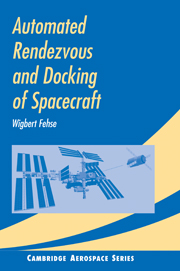Book contents
- Frontmatter
- Contents
- Preface
- List of symbols
- 1 Introduction
- 2 The phases of a rendezvous mission
- 3 Orbit dynamics and trajectory elements
- 4 Approach safety and collision avoidance
- 5 The drivers for the approach strategy
- 6 The onboard rendezvous control system
- 7 Sensors for rendezvous navigation
- 8 Mating systems
- 9 Space and ground system setup
- 10 Verification and validation
- Appendix A Motion dynamics
- Appendix B Rendezvous strategies of existing vehicles
- Appendix C Rendezvous vehicles of the ISS scenario
- Glossary
- References
- Index
8 - Mating systems
Published online by Cambridge University Press: 13 October 2009
- Frontmatter
- Contents
- Preface
- List of symbols
- 1 Introduction
- 2 The phases of a rendezvous mission
- 3 Orbit dynamics and trajectory elements
- 4 Approach safety and collision avoidance
- 5 The drivers for the approach strategy
- 6 The onboard rendezvous control system
- 7 Sensors for rendezvous navigation
- 8 Mating systems
- 9 Space and ground system setup
- 10 Verification and validation
- Appendix A Motion dynamics
- Appendix B Rendezvous strategies of existing vehicles
- Appendix C Rendezvous vehicles of the ISS scenario
- Glossary
- References
- Index
Summary
The objective of this chapter is to provide a basic understanding of the dynamic and kinematic processes which are taking place during docking or berthing of two vehicles, and to give an overview of the design principles used for docking and berthing mechanisms. Design driving requirements for these mechanisms are briefly discussed, and an overview of existing mechanism developments is given. The dynamic processes of contact and capture at docking are discussed using a simple model of an equivalent mass, which represents the masses of both spacecraft plus a central attenuation system. Basic functional concepts of the design elements used for shock attenuation, capture, structural connection and sealing are discussed at the end of the chapter.
Basic concepts of docking and berthing
The main tasks and issues arising during docking and berthing have already been addressed in section 2.5. Definitions of the terms ‘docking’ and ‘berthing’ have been given in chapter 1. For completeness of this chapter, these key definitions shall be recalled here.
As a general term for the process of achieving contact, capture and connection, the term mating is used. This includes the two cases ‘docking’ and ‘berthing’.
The term docking is used for the case where the GNC system of the chaser controls the required vehicle state parameters necessary to ensure that its capture interfaces enter into those of the target vehicle, and where the capture location is also the location for structural connection.
[…]
- Type
- Chapter
- Information
- Automated Rendezvous and Docking of Spacecraft , pp. 283 - 335Publisher: Cambridge University PressPrint publication year: 2003
- 1
- Cited by

